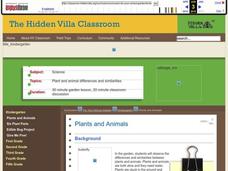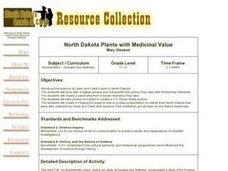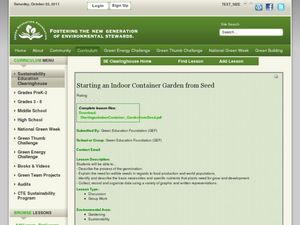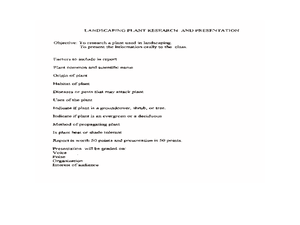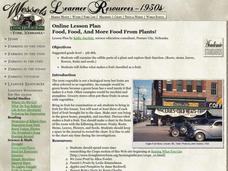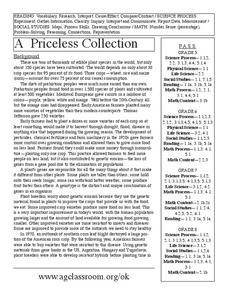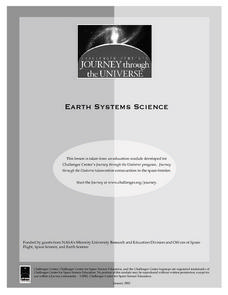Curated OER
Are Plants Useful to Man?
Here is a presentation geared toward very young learners. Each slide includes one or two sentences using simple text and related clip art to describe and illustrate one way we use plants in our everyday life. This PowerPoint provides...
Curated OER
Edible and Medicinal Plants: Field Trip Guide
Though it's designed to guide a field trip to the New York Botanical Garden, you could take resource like this one to a local park, wilderness area, school garden, or even a weedy empty lot. Middle schoolers identify plant parts and...
NOAA
Make an Edible Coral Reef
Coral reefs are full of an abundance of life and color. Why not celebrate it with an edible coral reef? Learners and teachers alike use cake, icing, and candies to create a tasty version of a coral reef that's complete with colors,...
Curated OER
Edible Bug Project
Students recognize the characteristics of insects. In this edible bugs lesson, students observe the body parts of an insect. Students create an edible insect using a grape, carrot sticks and sorrel stems and leaves. Students share the...
Curated OER
Edible Wild Plants
Learners explore the benefits of recognizing edible wild plants. In this wild plant lesson, students collect, make ready and eat edible plants. Learners answer questions about the plants.
Curated OER
Plants and Animals
Students taste test the garden. In this Science instructional activity, students compare and contrast plants and animals needs. Students pick fruits and vegetables in the garden and discuss their observations.
Curated OER
North Dakota Plants with Medicinal Value
Students use the internet and plant guides and other resources to identify plants and their medicinal importance as seen by the Native Americans. They view a copy of the Lewis and Clark journal that held photos of the plants of their...
Curated OER
Tutti Frutti
Get some competition going in your life science class. Give lab groups a variety of plant parts, all of them fruits, except one. Their mission is to make observations, compare and contrast, in order to be the first to identify the...
Curated OER
Parts of the Plants that we Eat
First graders study plants and their parts to see what parts are edible. In this plant lesson students are assigned plant parts and they are to put them in the right category.
Curated OER
First Nations Plants and their Uses
Students identify the uses of plants by researching Native Americans. In this First Nations culture lesson, students identify the First Nations coastal people of British Columbia and their use of plants such as seaweed, bark and moss....
Curated OER
Build a Coral Polyp
Students build a coral polyp out of a banana, straw, oyster crackers, sprinkles, and more. In this coral polyp lesson plan, students also list the differences between plants and animals.
Curated OER
Starting an Indoor Container Garden from Seed
Students create an indoor container garden. In this container garden lesson, students explore seed germination. Students discuss edible seeds.
Curated OER
Yummy Plant Parts
Students examine plant parts. For this botany lesson, students examine various edible plants and how their adaptations help them to grow. They observe stems, leaves, roots and flowers of plants and discuss the relationship between the...
Curated OER
Plant Life for Kids
In these plant life worksheets, students complete a worksheet about parts of a plant, plant life, plant life cycle sequence, and then complete a plant life mini book.
Curated OER
Plants, Plants, and More Plants
Students examine several types of plants. In this plant lesson, students complete activities that require them to identify types of plants, chart plant anatomy, and explain plant propagation.
Curated OER
Food, Food, And More Food From Plants!
Learners examine the edible parts of a plant and explore their function. They define what makes a fruit classified as a fruit. They create a sketch or map or photo of a 1930s farm and justify their plant selections.
Curated OER
Showing Nature's Way-Plant Development and the Plant Parts We Eat
Students explore plant life. In this science lesson plan, students demonstrate and record the stages of plant growth and categorize food plants by identifying the edible part.
Curated OER
A Priceless Collection
Students read and discuss the background of plants, seeds, and gene banks and grow seeds on their own. For this seeds lesson plan, students also use maps to identify seed banks and research plant farmers.
Curated OER
What is Rice?
Second graders investigate the agricultural process of rice farming by creating a rice stationary item. In this farming lesson plan, 2nd graders read about rice plants and the techniques used to harvest the edible plant. Students...
Curated OER
We Eat Plant Parts
For this edible plants worksheet, students study several elements to a root, leaf, fruit, and stem of a plant. Students complete several questions and draw the different elements.
Curated OER
Eat Your Plants
Students explore fruits and vegetables. In this fruits and vegetables lesson, students work in small groups investigating plant parts. Students discover that fruits and vegetables originate from different parts of plants.
Curated OER
soil, Water, and Plants
Students examine the relationship between water retention and plant growth by conducting two experiments. They first compare the water retention qualities of clay, sand and loam soil types. Then they use the data from the first...
Curated OER
Coral Polyp Party
Students complete a project where they label the parts of a coral polyp and discuss the differences between plants and animals. Students use marshmallows, sprinkles, toothpicks, and more to label their coral polyp.
Curated OER
What Parts of a Plant Do We Eat?
Did you know that tomtoes and cucumbers are actually fruits? Biology or botany beginners read about the function of flowers and fruit and find that some food items commonly called vegetables are, by definition, also fruits! Give learners...







